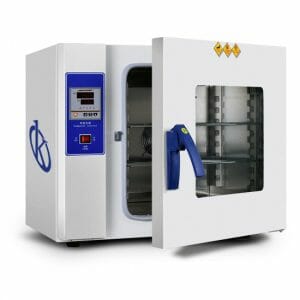A ovens is an essential instrument, both in clinical and scientific research laboratories, with its use can be removed, by drying and sterilizing, moisture from metal and glass containers, but also, its operation is applicable for samples of chemical and biological character. Due to its functionality, it is a team that should not be lacking, in order to have impeccable medical material used in patients or to evaluate samples.
ovens used in laboratories must be made of stainless steel, this increases their lifetime. In addition, they must have microprocessors that evenly distribute temperature throughout the equipment space. They should also have a display that allows the user to adjust the temperature.
Types of laboratory ovens that exist
Depending on the use to be given in the laboratory, there are two types of ovens, the ones that work by natural convection and the ones that work by forced convection. However, the main purpose of both is to extract moisture from instruments or samples that are introduced into it. The types of ovens that can be found on the market are defined below:
- Natural convection ovens: this type of equipment allows to take the cold air flows where the ovens is located and convert them into hot air, which is evenly distributed within the ovens. It has a simple operation that allows to sterilize a lot of materials.
- Forced convection ovens: in this type of equipment the air inside the machine is generated in a forced way, with air at room temperature. Thanks to its operation, it is possible to obtain a quick drying and heating of the material introduced into the ovens. They are especially useful because they generate greater temperature uniformity and also quickly recover the temperature after the door is opened and closed.
- Vacuum ovens: is a type of equipment that provides the drying of instruments at low temperature, thanks to its soft drying design for samples that are thermosensitive.
Operation of laboratory ovens
ovens are equipment that work with a microprocessor module, this allows the user to choose the operating parameters that they want and activate the alarms of the equipment in case of a failure. The heat produced by the ovens is given by the set of internal electrical resistors that these possess, transferring thermal energy to the internal chamber. The temperatures with which the ovens usually work are from room temperature to 350 °C.
The ovens must be equipped with a metal door, this gives thermal insulation, also has a handle of insulating material, avoiding putting at risk the hands of the user, by the interior heat it produces. The door is located at the front of the ovens , along with hinges that provide an opening with angles up to 180°.
Importance of laboratory ovens
ovens are essential devices in laboratories, have two tasks of great importance, these are the sterilizing and drying materials used in laboratories. In laboratories it is common to carry out experiments, tests or tests, making necessary the use of the ovens for washing, drying and sterilizing containers that are used daily. Although they are also useful when you want to dry or heat specific biological samples.
The ovens is a dry heat generator that provides an average temperature of 180 °C continuously operating during the time indicated by the user, allowing all material located in the drying cavity to be sterilized. The ovens has the ability to remove moisture and any sign of microorganisms found in the material to be dried.
Kalstein brand ovens
At kalstein we are MANUFACTURERS of ovens and a variety of clinical and laboratory equipment. We have the best PRICES and excellent quality, this allows us to assure you that your PURCHASE will be satisfactory. If you want to buy a ovens, we have vacuum heaters and industrial ovens. Our YR Series models have the following advantages: HERE
- The vacuum environment greatly reduces the need to get rid of the boiling point of the liquid, so the vacuum.
- Drying of heat sensitive material can be easily applied as it is not easy to use.
- Safety: under vacuum and inertia conditions, avoid completely exploding if the material is oxidized at a very high temperature.
To view our catalog of ovens, visit the following link HERE

